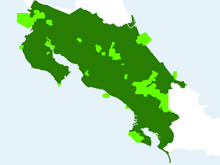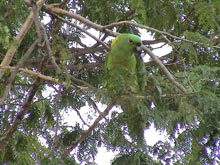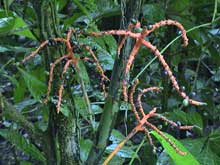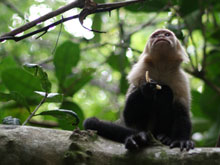National parks and integral nature reserves in Costa Rica
A quarter of the land of Costa Rica is protected by national parks, natural reserves, biological reserves or similar institutions.
But the human being has also destroyed an important portion of nature in Costa Rica. In the last 400 years 60 % of the woods in Costa Rica have been destroyed. During the colonial period 95 % of the dry woods in the lowlands were cut down to make room for cattle breeding. In other areas the vegetation had to give space for banana- and coffee plantations. The areas flanking the Manuel Antonio National Park are used for palm plantations, the oil of the palms is sold.
Now the goal is to use the resources in the best way without destroying them. A multiple of the space that is used to grow coffee and bananas is used for cattle breeding, though coffee and banana plantations are more profitable.
Hugh parts of the Corcovado national park have been devasted and contaminated with mercury by gold-diggers. Till this day there are still people digging illegally for gold, but those are very isolated cases.
Explore animals and plants in the rain forest...
In some areas it was necessary to form a compromise to improve the circumstances. The myth that the consumption of raw turtle eggs makes you more potent still exists and some families have lived from the income they made by selling the eggs for many years. Many of those people now work as guards in national parks to protect the eggs and turtles from poachers and other dangers. Volunteers often have to pay during their stay in a national park to help to cover the expenses.
Often it is legal to collect and sell the eggs of the turtles that come to the beach first, most of them would be destroyed by other turtles anyway.
The first national park that was created in Costa Rica was the Irazu Volcano national park in 1955. In the seventies a law stopped the export of over 60 rare and endangered species of trees. One of the consequences was that 1993, for the first time, Costa Rica had to import wood.
Thanks to the geographic situation, between the Caribbean and the pacific, and a strongly differing altitude profile Costa Rica offers an incomparable biodiversity of plants and animals on only 51100 square kilometers. Particular important in the nature is the rain forest, 50 % of all known animals and plants live or grow in it!
As opposed to many other sunny vacation destinations many tourists come to Costa Rica not only for sunbathing or relaxing at the beach. A lot of them want to explore some of the wonders of nature by themselves, which are easy accessible in this small country.
National parks and integral nature reserves in Costa Rica on the map

Facts about National parks and integral nature reserves in Costa Rica
- The Irazu volcano national park was the first national park in Costa Rica.
- Poas volcano national park is the most visited national park in Costa Rica.
- The Manuel Antonio national park is the smallest national park in Costa Rica.




